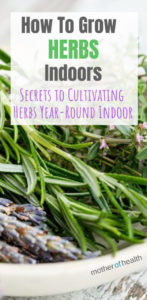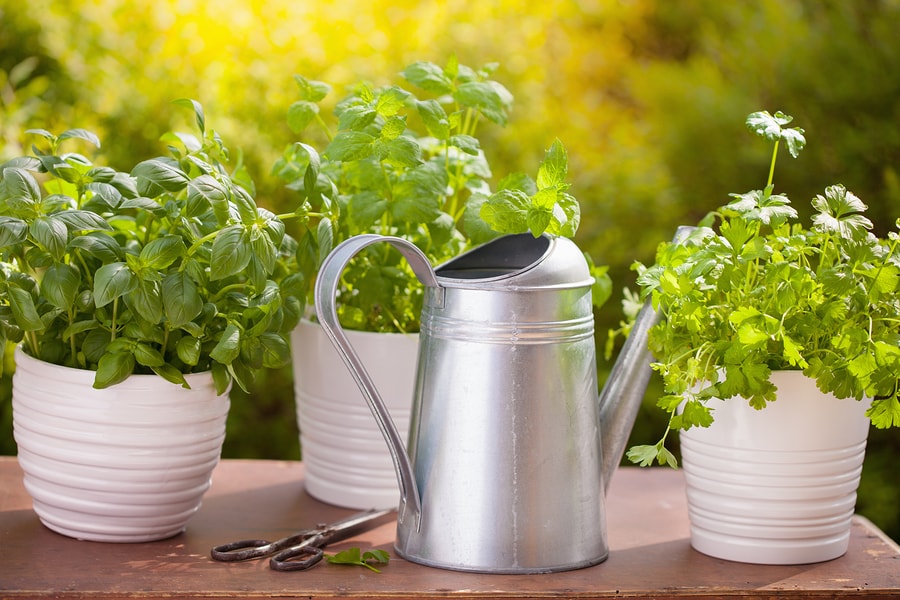Growing an indoor herb container is convenient and adds ease to the use of your favorite herbs. Most herb gardens grow happily indoors when you offer them adequate light. Ideally, the herb garden can enjoy the outdoor sunshine and fresh air for part of the day this time of year and any time temperatures are above 45 degrees F.
For most, the hardest part of learning how to grow herbs inside is getting the right amount of light to growing herbs. Full sun can sometimes come from a south or southwest facing window. In some situations, a grow light above a counter provides enough light.
Learning How to Grow Herbs Inside
Start Herbs from Seed

You can grow your indoor herb garden from seeds. Seeds need consistent moisture and a warm location.
Plant seeds into fresh soil in a container appropriate for your indoor area. Scatter seeds or plant into the area of the pot designated for that plant. Tiny seeds may be sown on top of the soil or lightly covered.
The bigger the seed, the deeper you plant it. Usually, you’ll plant no deeper than one inch. Soak larger seeds overnight or abrade them with sandpaper to break the tough outside coating.
You’ll thin seedlings later, but don’t plant too many, that is a waste. Cover until germination occurs if desired.
You may re-use covered containers, such as transparent plastic with lids attached, for seed germination. Open the top a few minutes each day to allow for air circulation.
You may want to plant your herbs into their permanent container from the beginning or move them into it later. If you're going to move them later, you can plant your seeds in biodegradable pots like these that you can transplant into permanent pots later.
Keep the seeds moist with a spray bottle of water if you tend to overwater in other ways. Locate the container in a warm area. Sun is optional for most seeds until they germinate.
Research your herbs before planting the first time so you'll learn all the details about each when learning how to grow herbs inside.
When seeds begin to sprout through the soil, provide sunlight or put them under the grow light setup. Seedlings get long and leggy if they must reach for the light.
Transplanting Your Herbs
You might dig up whole plants or parts of herbs from an outdoor growing garden in fall, pot them, and bring them indoors. Not all plants will quickly transition to indoor growing after they are accustomed to living outside.
When using this method, dig up small clusters that include the majority of the root ball. Don’t allow the roots to dry out while your clump is out of the ground. It is best to plant directly from the ground into the container in which your herb garden will grow.
Speaking of containers, you can grow all your herbs in one container or use several Some herbs are wonderful for adding fragrance to the home. P. Allen Smith plants some of his herbs in unique containers.
Grow the Herb Garden From Cuttings
Many herbs grow most efficiently from a healthy cutting, taken from a robust outdoor plant and placed into moist soil to take root. You may root cuttings to multiply your plants in spring, summer, or autumn. Some might even survive and grow inside when started in winter.
You’ll see the terms softwood and hardwood cuttings as you study the best way to accomplish this project.
Softwood cuttings are those with soft bendable stems, the new growth, and have green stems in most cases. Hardwood cuttings are those with breakable stems, usually brown. Both are equally viable for starting new plants, though it is often best to work with softwood cuttings in spring and hardwood in autumn.
Propagate cuttings of about four to six inches. Remove leaves from the bottom half of the cutting and pinch back the top set of leaves. Pinching breaks apical dominance. This is basically forcing the energy downward to develop roots when it is potted into moist soil.
All three methods of herb propagation have one thing in common; limited, consistent moisture is what they need, and no more.
Too much water causes seeds to rot away in the soil and drowns growing roots. Keep this in mind if you sometimes find yourself watering too often or too much.
Choose Herbs for Your Indoor Garden

The size of your pot determines how big your herb plants grow. Estimate the mature size each plant will reach and devote a section of each container to the herbs you will plant. Don't worry about over-growing; you'll likely want to change some of them out in a few months.
Get creative when choosing your container or pots. Upcycle something that matches your décor and to which you can quickly add drain holes.
Harvest your plant regularly. You’ll likely find plenty of uses for all herb plants. Clipping and trimming are good for your herbs and stimulates growth. For most extended life, prune flowers off before they bloom.
Choosing the herbs to fill your pot is the fun part of this chore. If you grow from seeds, you'll have a better selection and can produce more unusual and exotic herbs. Here are a few medicinal herbs from which to choose and expand upon.
One of the most rewarding things you can do is to grow an herb garden. There's nothing better than cooking with fresh herbs, both for the taste and health benefits. Herbs have powerful healing properties and are a great way to add nutrients to your diet. When you have an herb garden growing right inside your kitchen, you'll always have vitamins, antioxidants, antibacterial and anti-inflammatory benefits right at your fingertips! Happy planting, no matter the season!

By Becca Badgett
Becca is a long- time gardener with a passion for growing organically in the vegetable garden and sharing her experience. She believes everyone should grow a herb garden, inground or in containers and use those herbs on a regular basis to improve overall health. Her passion for growing led her to attend a Horticulture Program at a local community college and share what she’s learned with numerous articles on the web. She is certified in Greenhouse Management and Operations, Landscape Design and is licensed as an NC Pest Control professional. Take advantage of her expertise through our gardening articles and get your garden growing. She contributed to the book “How to Grow an Emergency Garden”, available on Amazon. Read it free on Kindle Unlimited

